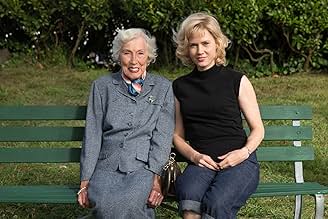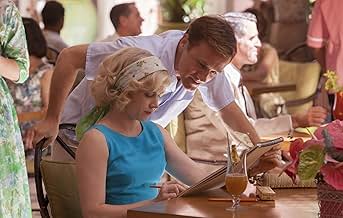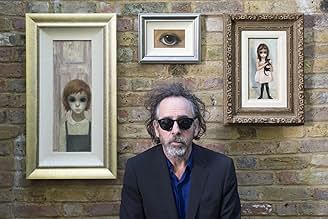Ein Drama über die Anfänge der Malerin Margaret Keane, ihren phänomenalen Erfolg in der 50er Jahren sowie die folgenden gerichtlichen Auseinandersetzungen mit ihrem Ehemann, der in den 60er ... Alles lesenEin Drama über die Anfänge der Malerin Margaret Keane, ihren phänomenalen Erfolg in der 50er Jahren sowie die folgenden gerichtlichen Auseinandersetzungen mit ihrem Ehemann, der in den 60er Jahren ihre Arbeiten für sich beanspruchte.Ein Drama über die Anfänge der Malerin Margaret Keane, ihren phänomenalen Erfolg in der 50er Jahren sowie die folgenden gerichtlichen Auseinandersetzungen mit ihrem Ehemann, der in den 60er Jahren ihre Arbeiten für sich beanspruchte.
- Regie
- Drehbuch
- Hauptbesetzung
- Nominiert für 2 BAFTA Awards
- 3 Gewinne & 18 Nominierungen insgesamt
- 2nd Olivetti Girl
- (as Emily Bruhn)
Empfohlene Bewertungen
And then there's the main problem: Christoph Waltz. He's not the only one at fault - his character goes from charming to cartoon villain which can certainly be blamed on the writers and Burton - but his over acted performance, particularly towards the end, completely obscured any depth that Walter's character may have had.
Amy Adams, on the other hand, is fantastic and certainly the movie's saving grace. I would have liked to see more of her relationship with Walter, more of what made her willing to keep cranking out paintings for her husband, though I suspect a more three-dimensional Walter would have been needed for that.
And the narrator/reporter was completely unnecessary. I kept forgetting he existed and then wondering who was talking for a few seconds before I remembered that the movie had a narrator.
All in all, entertaining but disappointing. 6/10
Amy Adams puts on a really good performance as Margaret. Much like her roles in "Junebug", "Enchanted" and "Doubt", her character's idealism collapses when faced with reality. Christoph Waltz turns Walter into a mixture of smooth and terrifying, but a real creep more than anything.
This is a very different turn for Tim Burton. Far from his homages to horror flicks and swipes at suburban America, he takes a serious approach to the subject matter. I recommend the movie. Whether you know of the story or not, you're sure to be impressed with the movie. Margaret's paintings might not appeal to you - they don't appeal to me - it's important to know what she went through, and the movie does a good job looking at that.
This film is a biopic of 1950s novelty pop artist Margaret Keane (formerly Ulbrich, nee Hawkins). She developed a series of haunting acrylic paintings of kids with big dark round eyes. Walter Keane, her rascal salesman of a husband, took advantage of the rising popularity of her paintings. He claimed and mass-marketed them as his own.
Meanwhile, timid Margaret was forced to conform to his web of lies. She was locked in her workroom in their home to paint even more Big Eyes, away from the prying eyes of the public, and even her own daughter. Will Margaret be able to break free from the prison she has trapped herself into?
Amy Adams quietly carried this film capably on her shoulders. There was nothing funny about what she had to do here as Margaret. Her character was the victim of a most cruel crime. Her husband stole not only her art, but also her confidence, and her very freedom. Adams played a weak character, but as an actress, Adams was anything but. With her wise underplaying, Adams successfully won our empathy and compassion for her difficult plight.
Christoph Waltz, on the other hand, was over-the-top, one-dimensional, practically cartoonish, as the manipulative con-man Walter. From his very first scene, you already knew this smooth-talking guy was up to no good. Up to his very last scene in that courtroom, Waltz's Walter was a manic caricature, never really coming across as a real person at all. This may well Tim Burton's direction in play, as this character Walter was the source of most of this film's black humor. Waltz's fiery interaction with Terence Stamp's harsh NY Times art critic character is most memorable as well.
This film's narrative was simple and straightforward. Yet because of Amy Adams' riveting and heart-rending performance, we will be held until the compelling end. The technical aspects of the film, particularly the pastel color palette of the photography, as well as the period production design, costumes and makeup, all contribute to the overall charming look and nostalgic feel of the film as a whole. 7/10.
The story of Big Eyes is something straight out of the movies, but no, the tale of Margaret Keane and her artistry is based on fact and real life.
Tim Burton's Big Eyes is a dramatic narrative of Margaret Keane, the painter, mother and wife. Having left her husband, with daughter in tow, she seeks a new beginning in California. While there, she hopes to make a living through her art and subsequently meets and marries a man named Walter. Trying to navigate the art world and make a living, her husband claims credit for her artwork which eventually becomes highly profitable. Burton focuses on the awakening of Keane as an artist and to her husband's shortcomings and the legal difficulties in claiming ownership of her work.
Margaret Keane's life is a fascinating and near unbelievable one. And much of Big Eyes' success as a film rests comfortably on that very story. Well, Big Eyes rests on the story of Keane and on Christoph Waltz's immeasurable charm in his performance as Walter Keane.
The sad big eyed children made commercially famous by Keane are uniquely peculiar. Stylistically, it was only right that Tim Burton should direct a film about the painter. It is apparent that Big Eyes is a Burton film; however, Tim Burton subdues his style substantially so that the narrative of this marvelous woman can take center stage. Creatively, this is a refreshing departure for the director.
The Big Eyes movie parallels the artwork of Margaret Keane in an unintentional manner. Margaret Keane was able to look at a person and capture their essence and then put it on canvas with her own twist through large sad eyes. Similarly, Tim Burton takes the core elements of Keane's life and translates it to film with his own fanciful creative liberties. Though everything is in the movie adaptation of Big Eyes, it lacks substance and heart to connect with the audience to have a lasting impression.
Please check out our WEBSITE for all the reviews of recent releases and awards contenders.
Wusstest du schon
- WissenswertesMargaret Keane: Reading a book on a park bench behind Margaret and Walter, when they paint in front of the San Francisco Palace of Fine Arts. The end-credit photo of her sitting with Amy Adams was taken when this scene was filmed.
- Patzer"Tomorrow Forever," the UNICEF painting Margaret Keane painted for the 1964 Worlds Fair, was never actually mounted in the Hall of Education. Robert Moses, who had control over everything that was included in the fair, hated it. Once New York Times critic John Canaday trashed it after seeing a photograph of it, Moses had it thrown into the garbage.
- Zitate
Ruben: What's that with the big crazy eyes?
Walter Keane: Oh. Well, I believe that you can see things in the eyes. The eyes are the window to the soul.
Top-Auswahl
- How long is Big Eyes?Powered by Alexa
Details
- Erscheinungsdatum
- Herkunftsländer
- Offizielle Standorte
- Sprachen
- Auch bekannt als
- Big Eyes - Sie malte es. Er verkaufte es. Und jeder wollte es haben.
- Drehorte
- Produktionsfirmen
- Weitere beteiligte Unternehmen bei IMDbPro anzeigen
Box Office
- Budget
- 10.000.000 $ (geschätzt)
- Bruttoertrag in den USA und Kanada
- 14.482.031 $
- Eröffnungswochenende in den USA und in Kanada
- 3.001.738 $
- 28. Dez. 2014
- Weltweiter Bruttoertrag
- 29.261.617 $
- Laufzeit1 Stunde 46 Minuten
- Farbe
- Sound-Mix
- Seitenverhältnis
- 1.85 : 1
Zu dieser Seite beitragen











































